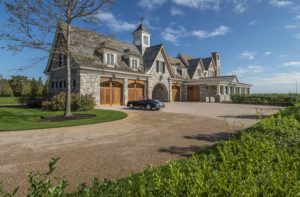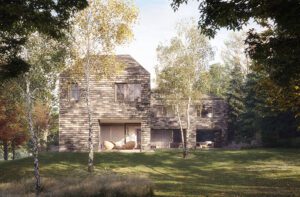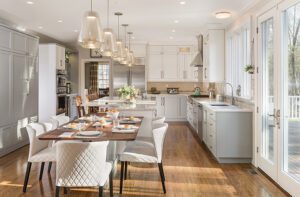Hidden Potential in Provincetown
June 4, 2019
Text by Debra Spark Photography by Sarah Winchester
Around town, people called it Casa Bacardi. Once a single-family house, it had become a Provincetown rental. Young “brand ambassadors” for Bacardi rum were regular summertime tenants. One of their duties? Riding the float for the annual Carnival parade. If you toured the property, you could pinch some of the liquor company’s promotional material from the basement.
By the time Ben and Pat Stone came across the house, it had been for sale for a few months: eons in Provincetown’s hot real estate market. The two-story structure, built around 1850 with a single-story addition tacked on in the 1970s, had a backyard and was well-located in a quiet block near the beach. Unfortunately, aluminum siding, plastic shutters, orange-yellow linoleum, and wall-to-wall carpeting dated the place.
The Stones knew they’d stumbled on an opportunity. As an interior designer, Pat wasn’t deterred by a fixer-upper. She could see the potential. “Ben is not a designer, but he has really good creative sensibilities, and he saw what I saw in it,” she says.
Their vision: an open, beachy, contemporary home, consistent with Cape vernacular, comfortable for entertaining, and with finishes sturdy enough for their three dogs. Getting there would involve two big structural changes: adding a second story over the addition and removing interior walls and ceilings. The couple turned to Cambridge, Massachusetts-based architect Scott Grady, a friend with whom they’d collaborated before.
Now, on approach, the house presents as a classic Cape with a simple primary gable, two dormers on a cross gable, black shutters, double-hung windows with black mullions, and a black asphalt roof. The front is clad in white clapboard, while the rest of the house wears cedar shingles, an aesthetic preference that historically began, Grady notes, as economic necessity. In earlier times, people used the more expensive clapboard only for the public-facing side of their homes. (Ironically, he observes, shingling is the pricier option today.)
The second-floor addition accommodates a spacious, high-ceilinged master bedroom suite and gives the home the massing it needed for overall balance. Windows are now arranged symmetrically around the front door. In the neighborhood, houses are tightly clustered and virtually flush to the street, but the Stones managed to add a gravel driveway and plant hydrangeas in front. Out back, they tiled half the yard in stone to create a patio, added a vegetable garden, and installed a synthetic grass lawn—a precaution given their dogs’ fondness for digging.
Inside, walls were removed downstairs to create an open plan with a kitchen and dining area to the left of a small front entry hall and a living room to the right. Upstairs, the addition allowed the existing rooms to be reconfigured to include a new bathroom for the two bedrooms. Though the guest rooms are small, removing the low ceilings has given them an airy feel.
Everything was brightened with new French doors at the back of the house, corner windows for the dining area, triple windows above the kitchen sink, and a window in the tip of the central gable. “I love light,” says Pat. “Who doesn’t?”
As often happens during a renovation, the job turned out to be much bigger than anticipated. Once builder Clifford Colby, who is now retired, began, it became clear how much of the house wasn’t up to code. “It was a typical P-town house,” says Pat of the wooden pegs still used for nails and other curiosities they found in the old part of the house. “It was like someone went down to the beach and nailed together scraps of wood.”
The house essentially needed to be rebuilt, wall by wall, with Armstrong Home Improvement coming on for the latter part of the project. From a financial point of view, it might have made more sense to tear down and start from scratch, but by renovating, the Stones were able to keep the historic stairwell and expose the living room ceiling beams as well as the corner posts and beams in the two guest rooms.
The interior design impulse was for something warm, minimal, and modern with a neutral palette of driftwood hues and pale grays. This meant combining traditional cottage finishes—like the horizontal shiplap on the ground-floor walls and the beadboard between the ceiling beams in the living room—with contemporary detailing. In the kitchen those modern touches include the marble-topped island, a backsplash of glass subway tile, and multi-sided glass pendant lamps. Pat found Nathan Yoder, an Indiana carpenter and supplier of reclaimed barn wood, on Etsy. He provided the wood and built or collaborated on the kitchen island and floating kitchen shelves as well as the master bath vanity. Elsewhere in the house, Pat outfitted the rooms in a mix of contemporary furniture from nationally known companies and pieces she found in favorite local boutiques and antique shops.
Brighter color enters the house through art, as with Chris Wyllie’s aqua grid of small seascape paintings in a guest room. The Stones’ art collection includes photographs by their daughter Caitlin and pieces procured from local galleries, such as the large landscapes by local artist Michael del Visco. Another bedroom holds a playful photo-realist painting by Hank Hudson that depicts James Bond emerging from the ocean, a work that would be called pointillist if the dots in pointillist paintings were each several inches wide. The couple came home from a trip to the Italian coastal towns of Cinque Terre with a collection of handmade blue ceramic fish, which now swim happily on the wall behind the master bed. A stairwell shows off a second school of decorative fish placed so they seem to be poking their gold heads through the wall.
Though Pat and Ben, who publishes a trade wine and spirits magazine, commute to Boston via plane or ferry, they spend as much time as possible in Provincetown. “The skies are not like anywhere in the world. The sunsets are not like anywhere in the world,” says Ben, noting that the unusual light has always attracted artists.
And a final reason the beach house pulls the couple back? “When we walk in, we are just so happy,” says Pat.
Project Team
Architecture: Scott William Grady, Scott William Grady Architect
Interior design: Patricia Stone, Patricia Stone Interiors
Builder: Artur Aguiar, Armstrong Home Improvement
Share
![NEH-Logo_Black[1] NEH-Logo_Black[1]](https://www.nehomemag.com/wp-content/uploads/2022/08/NEH-Logo_Black1-300x162.jpg)




















You must be logged in to post a comment.